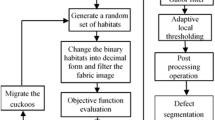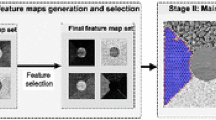Abstract
This paper presents an efficient and practical approach for automatic, unsupervised object detection and segmentation in two-texture images based on the concept of Gabor filter optimization. The entire process occurs within a hierarchical framework and consists of the steps of detection, coarse segmentation, and fine segmentation. In the object detection step, the image is first processed using a Gabor filter bank. Then, the histograms of the filtered responses are analyzed using the scale-space approach to predict the presence/absence of an object in the target image. If the presence of an object is reported, the proposed approach proceeds to the coarse segmentation stage, wherein the best Gabor filter (among the bank of filters) is automatically chosen, and used to segment the image into two distinct regions. Finally, in the fine segmentation step, the coefficients of the best Gabor filter (output from the previous stage) are iteratively refined in order to further fine-tune and improve the segmentation map produced by the coarse segmentation step. In the validation study, the proposed approach is applied as part of a machine vision scheme with the goal of quantifying the stain-release property of fabrics. To that end, the presented hierarchical scheme is used to detect and segment stains on a sizeable set of digitized fabric images, and the performance evaluation of the detection, coarse segmentation, and fine segmentation steps is conducted using appropriate metrics. The promising nature of these results bears testimony to the efficacy of the proposed approach.
Similar content being viewed by others
References
Escofet J., Navarro R., Millan M., Pladellorens J.: Detection of local defects in textile webs using Gabor filters. Opt. Eng. 37(8), 2297–2307 (1998)
Serdaroglu A., Ertuzun A., Ercil A.: Defect detection in textile fabric images using wavelet transforms and independent component analysis. Pattern Recognit. Image Anal. 16(1), 61–64 (2006)
Jain R., Rao A., Kayaalp A., Cole C.: Machine vision for semiconductor wafer inspection. In: Freeman, H. (eds) Machine Vision for Inspection and Measurement, pp. 283–314. Academic Press, New York (1989)
Kimmel R., Malladi R., Sochen N.: Images as embedded maps and minimal surfaces: movies, color, texture, and volumetric medical images. Int. J. Comput. Vis. 39(2), 1405–1573 (2000)
Wei D., Chan H.P., Helvie M.A., Sahiner B., Petrick N., Adler D.D., Goodsitt M.M.: Classification of mass and normal breast tissue on digital mammograms: multiresolution texture analysis. Med. Phys. 22(9), 1501–1513 (1995)
Tuceryan, M., Jain, A.K.: Texture Analysis. The Handbook of Pattern Recognition and Computer Vision, pp. 207–248. World Scientific Publishing Co., NJ (1998)
Daugman J.: Uncertainty relation for resolution in space, spatial frequency, and orientation optimized by two-dimensional visual cortical filters. J. Opt. Soc. Am. A 2(7), 1160–1169 (1985)
Dunn D., Higgins W.E.: Texture segmentation using 2-D Gabor elementary functions. IEEE Trans. Pattern Anal. Mach. Intell. 16(2), 130–149 (1994)
Dunn D.: Optimal Gabor filters for texture segmentation. IEEE Trans. Image Process. 4(7), 947–964 (1995)
Weldon, T.P., Higgins, W.E., Dunn, D.: Efficient Gabor filter design using Rician output statistics. In: IEEE International Symposium on Circuits and Systems, vol. 3, London, England, 30 May–2 June 1994
Bovik A.C.: Analysis of multichannel narrow-band filters for image texture segmentation. IEEE Trans. Signal Process. 39(9), 2025–2043 (1991)
Ahmadian, A., Mostafa, A.: An efficient texture classification algorithm using Gabor wavelet. In: Proceedings of IEEE EMBS Cancun, Mexico, September 17–21, 2003
Kumar A., Pang G.K.H.: Defect detection in textured materials using Gabor filters. IEEE Trans. Ind. Appl. 38(2), 425–440 (2002)
Cohen H.A., You J.: A multi-scale texture classifier based on multiresolution ‘tuned’ mask. Pattern Recognit. Lett. 13, 599–604 (1992)
You J., Cohen H.A.: Classification and segmentation of rotated and scaled textured images using texture ‘tuned’ mask. Pattern Recogni. Lett. 26, 245–258 (1993)
Randen, T., Husoy, J.H.: Texture segmentation using filters with optimized energy separation. IEEE Trans. Image Process. 8(4) (1999)
Duda R.O., Hart P.E., Stork D.G.: Pattern Classification. Wiley Interscience, New York (2001)
Carlotto M.J.: Histogram analysis using a scale-space approach. IEEE Trans. Pattern Anal. Mach. Intell. 9(1), 121–129 (1987)
Shi J., Malik J.: Normalized cuts and image segmentation. IEEE Trans. Pattern Anal. Mach. Intell. 22(8), 888–905 (2000)
Xiao J., Shah M.: Motion layer extraction in the presence of occlusion using graph cuts. IEEE Trans. Pattern Anal. Mach. Intell. 27(10), 1644–1659 (2005)
Zhang W., Cao X., Qu Y., Hou Y., Zhao H., Zhang C.: Detecting and extracting the photo composites using planar homography and graph cut. IEEE Trans. Inform. Forensic Secur. 99, 544–555 (2010)
AATCC: Test Method 130-1995. AATCC Technical Manual, pp. 217–219 (1995)
Xu B., Reed J.A.: Instrumental evaluation of stain release in fabrics. J. Text. Inst. 87(1), 203–211 (1996)
Gururajan, A., Sari-Sarraf, H., Hequet, E.: A statistical approach to defect detection and multi-scale localization in two-texture images. Opt. Eng. 47, 027202-1–027202-10 (2008)
Gururajan A., Hequet E., Sari-Sarraf H.: Objective evaluation of soil release in fabrics. Text. Res. J. 78(9), 782–795 (2008)
Papoulis A.: Probability, Random Variables and Stochastic Processes, 3rd edn. McGraw-Hill, New York (1991)
Whalen A.D.: Detection of Signals in Noise. Academic Press, New York (1971)
Unser M.: Local linear transforms for texture measurements. Signal Process. 11(1), 61–79 (1986)
Mathews J.H., Fink K.K.: Numerical Methods Using Matlab, 4th edn. Prentice Hall, NJ (2004)
Randen T., Husoy J.H.: Filtering for texture classification: a comparative study. IEEE Trans. Pattern Recognit. Mach. Intell. 21(4), 291–310 (1999)
Cohen H.A., You J.: A multi-scale texture classfier based on multiresolution tuned mask. Pattern Recognit. Lett. 13, 599–604 (1992)
You J., Cohen H. A.: Classification and segmentation of rotated and scaled textured images using texture ‘tuned’ mask. Pattern Recognit. Lett. 26, 245–258 (1993)
Huo Z. M., Giger M. L.: Evaluation of an automatic segmentation method based on performances of an automatic classification method. Proc. SPIE 3981, 16–21 (2000)
Author information
Authors and Affiliations
Corresponding author
Rights and permissions
About this article
Cite this article
Mao, C., Gururajan, A., Sari-Sarraf, H. et al. Machine vision scheme for stain-release evaluation using Gabor filters with optimized coefficients. Machine Vision and Applications 23, 349–361 (2012). https://doi.org/10.1007/s00138-010-0295-7
Received:
Revised:
Accepted:
Published:
Issue Date:
DOI: https://doi.org/10.1007/s00138-010-0295-7




